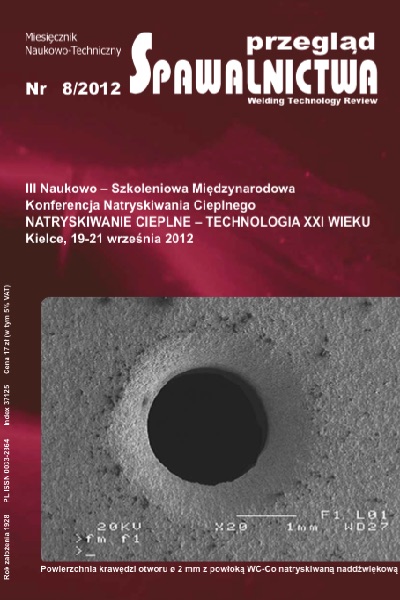Tribological properties of plasma and HVOF sprayed composite coatings
##plugins.themes.bootstrap3.article.main##
Abstrakt
This paper presents the properties of plasma and HVOF thermally sprayed coatings obtained by blending the niCrBSi and Fe2O3 powders. The deposition was performed by means of the Plancer PN-120 and the Diamond Jet guns for plasma spraying and HVOF spraying, respectively. The SEm (EDS) and XRD methods were employed to study the microstructure and phase com- position of the produced coatings. Although the blended powders differ in particle size, shape, and distribution, it is possible to obtain composite coatings with an niCrBSi matrix containing iron oxides. Except for a different microstructure, plasma and HVOF coatings have a different phase composition, which was examined using the Bruker D-8 Advance diffractometer. Studies of the coatings wear and scuffing resistance showed that an optimal content of Fe2O3 is about 26% for plasma sprayed coatings and 22,5% for HVOF deposited coatings.
Trybologiczne właściwości powłok kompozytowych natryskanych plazmowo i HVOF
Abstrakt
W pracy przedstawiono właściwości natryskanych plazmowo i HVOF powłok otrzymanych w wyniku wymieszania proszków niCrBSi i Fe2O3. natryskiwanie przeprowadzono w za pomocą plazmotronu Plancer PN-120 i systemu do natryskiwania naddźwiekowego Diamond Jet. Badania mikrostruktury i składu fazowego natryskanych powłok przeprowadzono wykorzystując SEM (EDS) i XRD. Wyniki ujawniły, że pomimo znacznych różnic wielkości, kształtu i rozkładu granulometrycznego proszków, możliwe jest uzyskanie powłok kompozytowych na osnowie NiCrBSi zawierających tlenki żelaza. Stosując dyfraktometr Bruker D-8 Advance, wykazano, że oprócz różnic mikrostrukturalnych, powłoki mają również odmienny skład fazowy. Badania zużycia powłok i ich odporności na zatarcie wykazały, że optymalna zawartość Fe2O3 wynosi ok. 26% dla powłok natryskiwanych plazmowo i 22,5% dla HVOF.
Pobrania
##plugins.themes.bootstrap3.article.details##
Creative Commons CC BY 4.0 https://creativecommons.org/licenses/by/4.0/
Artykuły czasopisma Welding Technology Review (Przegląd Spawalnictwa) publikowane są w otwartym dostępie na licencji CC BY (licencja Creative Commons Uznanie autorstwa 4.0 Międzynarodowe). Licencja CC BY jest najbardziej otwartą dostępną licencją i uważaną za „złoty standard” w formule otwartego dostępu; jest również preferowany przez wielu fundatorów badań. Licencja ta umożliwia czytelnikom kopiowanie i redystrybucję materiału na dowolnym nośniku i w dowolnym formacie, a także zmienianie, przekształcanie lub budowanie na nim materiału, w tym do użytku komercyjnego, pod warunkiem wskazania oryginalnego autora.
Bibliografia
Tucker R.C., Treglio J.: Proc. of International Thermal Spray Conference, Seattle 2006, s. 458-463.
Dahorte n.B., nayak S.: nanocoatings for engine application. Surface & Coatings Technology 194 (2005) 58-67.
Vetter J., Barbezat B., Crummenauer J., Avissar J.: Surface & Coating Technology 200 (2005) 1962-1968.
Pawlowski L.: The science and engineering of thermal spray coatings. 2nd ed. John Wiley & Sons, Chichester 2008.
Barbezat G.: Surface & Coating Technology 201 (2006) 2028- 2031.
ErnstP.,BarbezatG.:Thermalsprayapplicationinpowertrain contribute in saving of energy and material resources. Surface and Coatings Technology 202 (2008) s. 4428-4431.
Handbook of Thermal Spray Technology; J.R. Davis, Davis & Associates, ASm International 2004.
Bobzin K., Schlaefer T., Warda T., Schlaefer m.: Proc. of International Thermal Spray Conference, Singapoure 2010, s. 173-177.
Shin J-H., Lim D-S., Ahn H-S.: Surface & Coating Technology 133-134 (2000) 403-410.
Singh V.P., Sil A., Jayaganthan R., materials & Design, 32 (2011) s. 584-591.
